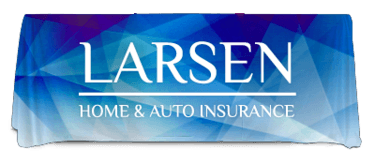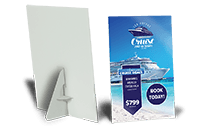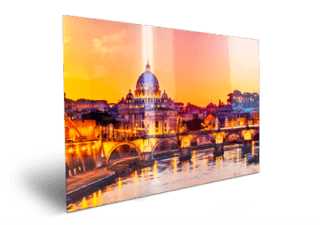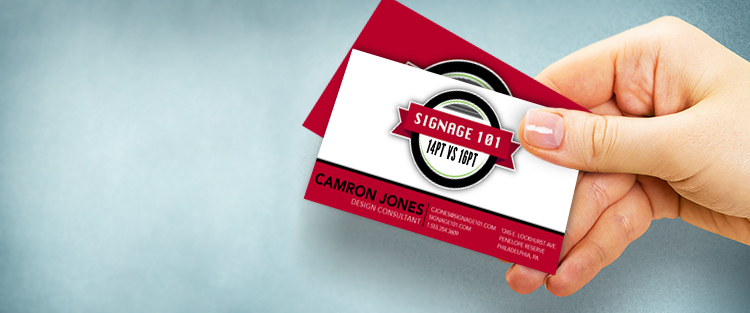Whether it’s business cards, flyers, brochures, rack cards, hang tags, door hangers, or any other type of small format printing, you will inevitably run into 14pt vs 16pt. Is there really a difference? If so, what is it? Are there any other options? Which one is best for business cards?
14pt Cardstock
First, let’s look at 14pt cardstock. 14pt cardstock is the more common option due to the fact that it is cheaper than 16pt cardstock. Although it is not as stiff as 16pt, it still has a rigid feel to it and will not flop/bend on its own. 14pt also has the same printing quality as 16pt. Because it is more cost-effective, 14pt is a great option if you are looking to do large quantities.
Products that use 14pt Cardstock
16pt Cardstock
The second option is 16pt cardstock. 16pt cardstock is thicker than 14pt, and as a result, has a higher quality feel. The added thickness also makes it more durable and longer lasting than 14pt. This is a better option for business cards if you are going to carry them with you in your wallet or purse, as they are less likely to bend, crease or get damaged corners.
Products that use 16pt Cardstock
100lb Glossbook
The third and final option is 100lb gloss book paper (sometimes written as 100# paper). 100lb paper is more commonly used for things like brochures and flyers–things that will be handed out in large quantities. It is both thinner and cheaper than 14pt and 16pt cardstock. 100lb glossbook paper has a similar feel to regular printing paper, but is slightly thicker. It is very flexible. It can be bent and folded, making it a great option for folded brochures like bifolds, trifolds, and z-folds.
Products that use 100lb Glossbook
14pt Vs 16pt
14pt and 16pt are the most common thicknesses for business cards. Visually, there isn’t much of a difference between the two. 14pt cardstock and 16pt cardstock look very similar side-by-side, but when multiple are stacked together, the difference becomes more apparent:
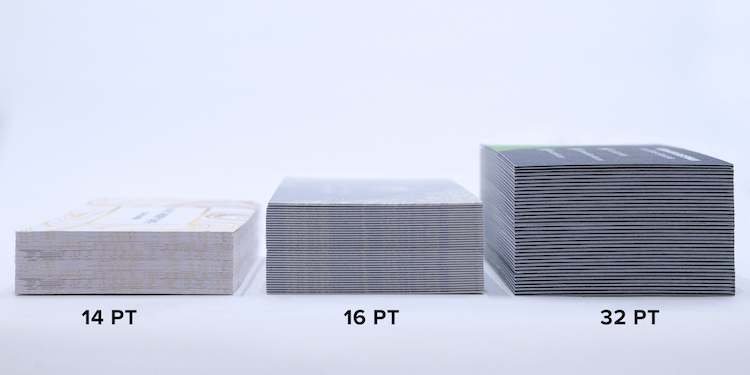
Although they may look similar, the real difference is in the feel: 16pt cardstock is noticeably stiffer than 14pt cardstock.
Best Thickness for Business Cards
The best thickness for your business cards largely depends on their intended use. If you’re going to be handing a lot of business cards out, for example, leaving a bunch in a restaurant or handing them out at a booth at a trade show, you probably want to choose 14pt. They are cheaper and still maintain a high quality look and feel. If you are planning on carrying a few with you at a time and handing them out to people you meet, you probably want to choose 16pt. Overall, we recommend 16pt cardstock. It feels nicer and is more durable than 14pt. The cost difference is minimal for the added benefit.
If you really want a high quality and impressive business card, check out our 32pt business cards–double the thickness of 16pt!
GSM
In reference to paper, GSM stands for grams per square meter. GSM is a common measurement used to better understand the quality of paper: the higher the GSM, the heavier the paper. See the table below for a GSM comparison:
| GSM | Use |
| 35gsm – 55gsm | Newspaper |
| 90gsm – 100gsm | Common printing paper |
| 120gsm – 140gsm | Brochures, flyers, |
| 210gsm – 300gsm | Magazine covers and Light Cardstock |
| 350gsm – 400gsm | Thick cardstock |
Thickness
14pt cardstock and 16pt cardstock both get their names from their thickness. Each ‘point’ is equal to .001 of an inch. For example, a 10pt cardstock would be .01 inches thick. 14pt cardstock is .014 inches thick, 16pt cardstock is .016 inches thick, and so on.

Still have questions? Feel free to contact our customer service team by calling 888-222-4929.













